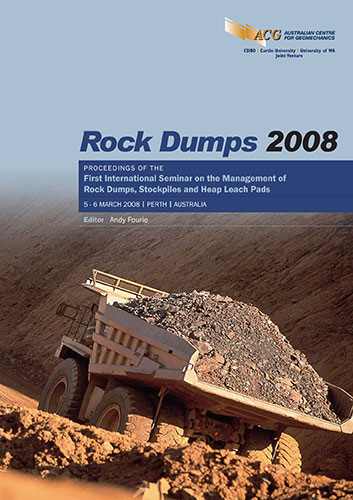Development of a Rock Dump Scheduling Model Using Linear Programming

|
Authors: Williams, DJ; Topal, E; Zhang, N; Scott, P |
DOI https://doi.org/10.36487/ACG_repo/802_11
Cite As:
Williams, DJ, Topal, E, Zhang, N & Scott, P 2008, 'Development of a Rock Dump Scheduling Model Using Linear Programming', in AB Fourie (ed.), Rock Dumps 2008: Proceedings of the First International Seminar on the Management of Rock Dumps, Stockpiles and Heap Leach Pads, Australian Centre for Geomechanics, Perth, pp. 129-137, https://doi.org/10.36487/ACG_repo/802_11
Abstract:
This paper describes the preliminary development and application of a rock dump scheduling model, using the operations research technique mixed-integer linear programming implemented in the mathematical modelling language AMPL. The development of the model is initially being focussed on minimising the haulage cost for each open pit block of waste rock to be placed in the rock dump, with some allowance for the selective placement of benign and reactive waste rock, based on an open pit block model that delineates ore, and benign and reactive waste rock. The current formulation is a very simple 3-D model, which will later be implemented using real mine data to fully demonstrate its application. Required input data include xyz-coordinates of the block model for the open pit, identification of whether the waste rock blocks are benign or reactive, the proposed time scheduling of waste rock haulage from the open pit, unit haulage costs, and the geometry of the rock dump and delineation of which zones are to be benign and which reactive. Other parameters to later be added to the model will include the cost of the land covered by the rock dump; the haul road routes between the pit and the dump in xyz-space enabling estimation of haulage distances, grades and actual haulage costs; alternative mining methods; in-pit dumping; topsoil and clay stripping and stockpiling for later rehabilitation purposes; the selective placement of benign and reactive rock to encapsulate the reactive rock; rock dump landform shaping; cover placement; and slope treatment. The model will ultimately provide a tool for rock dump scheduling that meets both the operator’s economic and environmental goals.
References:
Alford, C. (1995) Optimisation in underground mine design. Proceedings of XXV APCOM Symposium, Brisbane,
Australia, 9-14 July 1995, pp. 213-218.
AusIMM (1993) Cost estimation handbook for the Australian mining industry, pp. 279-280.
Dagdelen, K. (1985) Optimum multi period open pit mine production scheduling. PhD Thesis, Colorado School of
Mines, USA.
Hartman, H.L. and Mutmansky, J.M. (2002) Introductory Mining Engineering, Second Edition, pp. 2-3. John Wiley and
Sons.
Johnson, T.B. (1968) Optimum pit mine production scheduling, Technical Report, University of California, Berkeley.
Kleinmann, R.L.P. (1991) Acid mine drainage: An overview. Proceedings of ASCE Specialty Conference on Energy in
the 90’s, Pittsburgh, USA, 10-13 March 1991, pp. 281-286.
Nehring, M. and Topal, E. (2007) Production schedule optimisation in underground hard rock mining using mixed
integer programming, Proceedings of Project Evaluation Conference, Melbourne, Australia, 19-20 June 2007,
pp. 169-175.
Ramazan, S. (2007) The new fundamental tree algorithm for production scheduling of open pit mines. European Journal
of Operational Research, 177(2), pp. 1153-1166.
Topal, E. (2003). Advanced underground mine scheduling using mixed integer programming. PhD Thesis, Colorado
School of Mines, USA.
Trout, L.P. (1995) Underground mine production scheduling using mixed integer programming. Proceedings of XXV
APCOM Symposium, Brisbane, Australia, 9-14 July 1995, 1995, pp. 395-400.
Wilke, F.L. and Reimer, T. (1977) Optimising the short term production schedule for an open pit iron ore mining
operation. Electronics Letters, pp. 425-433.
Williams, D.J., Stolberg, D.J. and Currey, N.A. (2006) Long-term performance of Kidston’s “store/release” cover
system over potentially acid forming waste rock dumps. Proceedings of Seventh International Conference on
Acid Rock Drainage, St Louis, Missouri, USA, 26-30 March 2006, pp. 2385-2396.
Management and Operations
Rock Dumps 2008, Perth, Australia 137
© Copyright 2025, Australian Centre for Geomechanics (ACG), The University of Western Australia. All rights reserved.
View copyright/legal information
Please direct any queries or error reports to repository-acg@uwa.edu.au
View copyright/legal information
Please direct any queries or error reports to repository-acg@uwa.edu.au